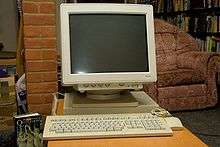Network Computing Devices
Network Computing Devices (NCD) was a company founded in 1987 to produce a new class of products now known as a "thin client". It was founded in Mountain View, CA, and when it closed it was headquartered in Beaverton, Oregon.

The corporate founders were Mike Harrigan, Doug Klein, Dave Cornelius, Ed Basart, Martin Eberhard, and Kevin Martin.
At that time these devices were known as network terminals or X Terminals. Judith Estrin and William Carrico joined the company about 6 months after its founding as its new CEO and executive vice president, and led the company through its IPO in 1992. The products were some of the earliest examples of a thin client and providing remote access to data in something other than ASCII as was common with traditional terminals of the time.
The X Protocol provided a way to show high resolution images of data and graphics over a network connection. NCD supported a range of network protocols including TCP/IP, token ring, DECnet and others.
Acquisitions
NCD purchased PCXware, which made an X Window System for Microsoft Windows.[1]
NCD purchased Z-Code Software in 1994. Z-Code made Z-Mail, a cross platform open standards email client. Z-Mail was later sold by NCD to Netmanage.
NCD purchased TekXPress X-terminals line from Tektronix.[2]
NCD ceased operations in 2004. However, a few of the company's employees have set up a new company, ThinPATH Systems,[3] to provide former NCD customers and others with service, support and products.
See also
- DESQview/X, a similar product
References
- Joanie M. Wexler (May 10, 1993). "NCD beefs up X software for Windows". Computerworld. p. 59. Retrieved February 21, 2017.
- John Cox (November 23, 1998). "NCD's thin clients get a multimedia boost in buyout". Network World. p. 12. Retrieved February 21, 2017.
- http://www.tp-sys.com
External links
- http://www.ncd-x.com
- NCD X-Terminal HOWTO
- National Semiconductor & NCD to Jointly Develop Information Appliances
Business Wire, Nov 14, 2000 - Network Computing Devices - NCD - Acknowledged by Australian Government Technology Productivity Award
Business Wire, March 28, 2001 - Network Computing Devices, Inc. Introduces NCD ThinPATH PC; New Software Manages PCs as Thin Clients, Reducing the Total Cost of Ownership of the Desktop
Business Wire, March 27, 2002 - NCD is Finalist in The Computing Industry Awards 2002; Newly Launched ThinPATH PC is Selected as a Finalist in the Computing Industry Awards
Business Wire, August 13, 2002